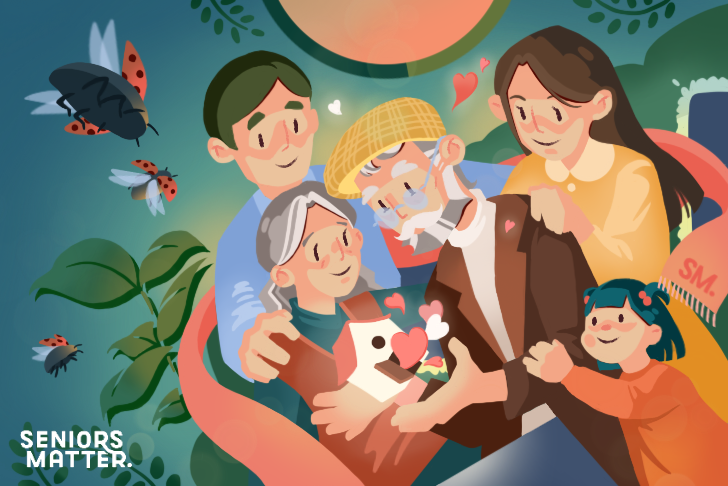
It’s hard to see a loved one lose their independence, but when seniors can no longer take care of their homes or themselves, it may be time to explore a new living situation. We’ve created this guide to help caregivers make the difficult decision of whether to hire, help or move their loved one into a safe forever home.
Signs your loved one should no longer live alone
In some cases, seniors who are overwhelmed with cleaning, landscaping, and dealing with physical ailments make the decision on their own to hire help or move into an assisted living facility. However, many seniors will insist they are self-sufficient in order to avoid having to leave their familiar home. Because of this, it’s important for family members to look for signs that their loved ones need more help. Some of these signs include:
Physical changes
- Falling, or a frailness that can easily cause them to fall
- Consistent weight loss or changes in appetite
- An unkempt appearance showing a lack of bathing and grooming
- More clutter in the home than usual
- Inability to keep up with yard work
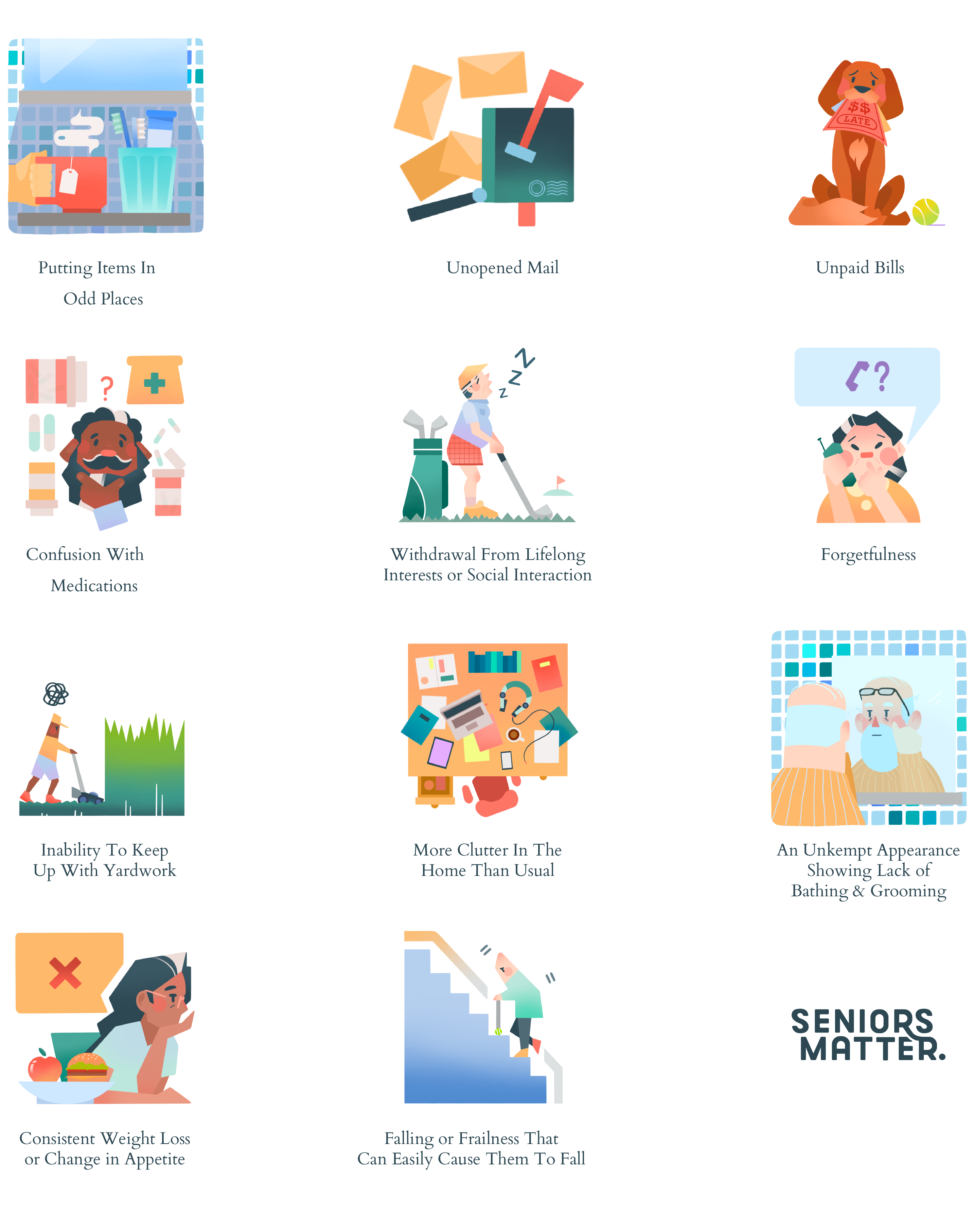
Mental changes
- Forgetfulness
- Withdrawal from lifelong interests or social interaction
- Confusion with medications
- Unpaid bills
- Unopened mail
- Putting items in odd places
- Friends and neighbors noticing habit changes, such as wandering or not coming out of the house as much as usual
Measuring the level of senior care needed
If you suspect your loved one could benefit from living in an assisted environment, the Katz Index of Independence in Activities of Daily Living (ADL) chart may help you to assess the level of care needed. This chart, developed by Dr. Sidney Katz in the 1960s, measures how well a senior can perform six categories of essential day-to-day routines independently. Your loved one will receive a score of “1” if they can complete the task, or “0” if they can’t. Once that is done, the numbers will be added. The higher the total, the more independent a patient is able to live.
Try the chart below based on your knowledge of your loved one. If he or she scores between 4 and 6, they have a fairly easy time completing basic functions and may still be able to live alone with some help. But if they score only 0 to 3, they most likely need a more consistent type of senior care.
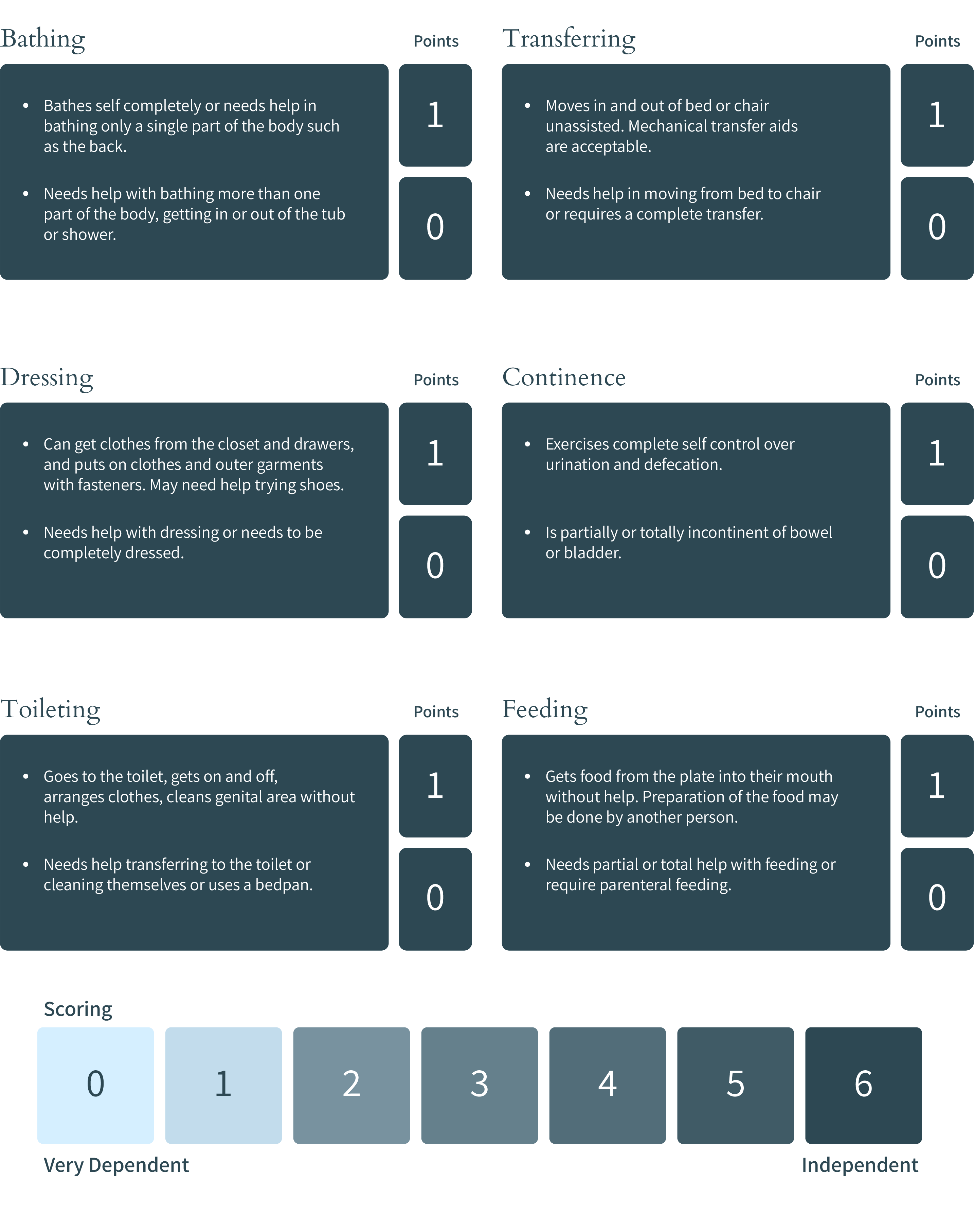
Once ADLs are measured, it’s time to measure more complex activities that allow (are instrumental for) a senior to live independently in their community. Health professionals use the Lawton Instrumental Activities of Daily Living Scale (IADL) to assess eight domains of function that are not essential for survival but that are important for safety, cleanliness, etc. A summary score ranges from 0 (low function, dependent) to 8 (high function, independent) for women, and 0 through 5 for men. In some cases, IADL deficiencies may be managed by a private care provider, a meal preparation or delivery service, a housekeeper, or a money management professional.
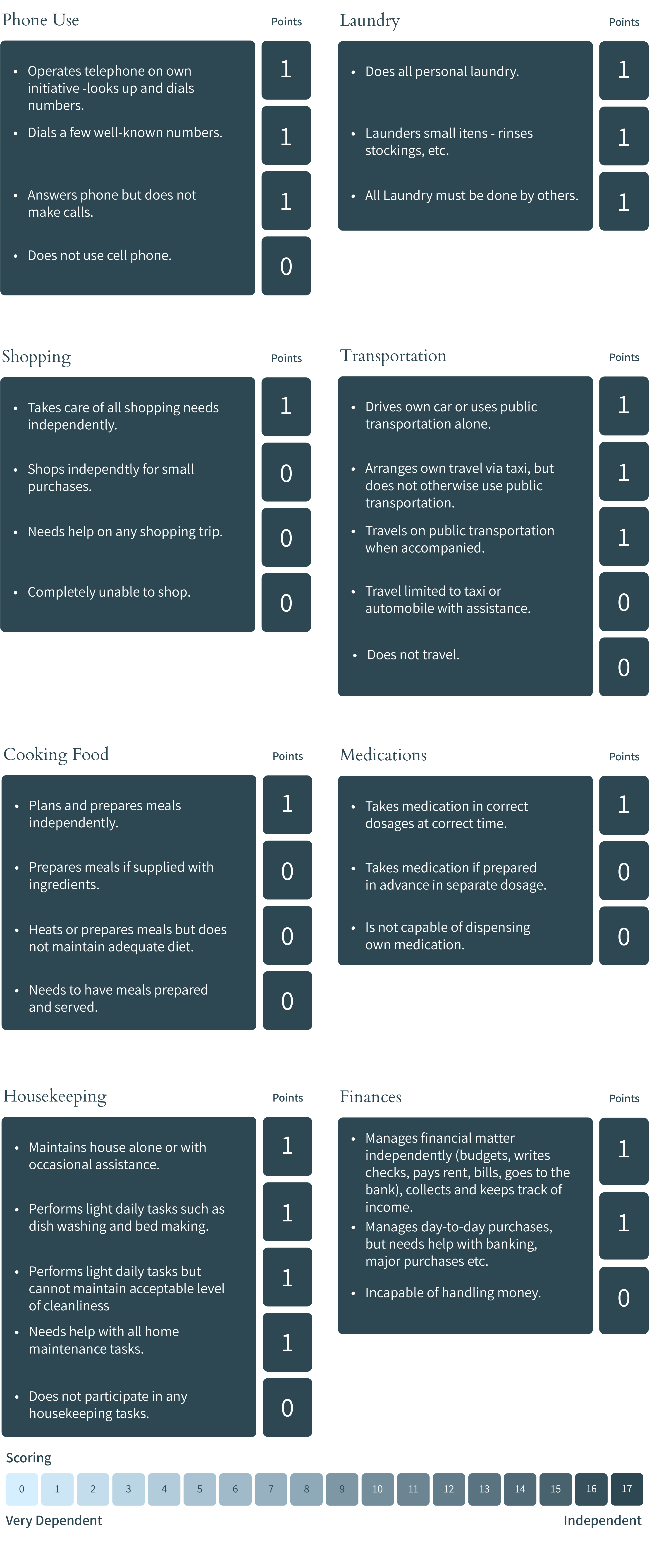
8 questions to ask to determine the need for assistance
Did your loved one score low on ADLs?
- If your loved one scored low on the Katz ADL assessment, an assisted living facility can help with bathing, dressing, mobility, and medication.
Could your loved one benefit from medical care coordination?
- Patients who frequently need to see doctors, physical therapists, and other health professionals can find all of these providers in an assisted living facility.
Is home and yard upkeep overwhelming?
- Long-term care facilities offer services including dusting, bed-making, bathroom cleaning, laundry, and general maintenance that takes away physical stress from residents.
Is adequate nutrition a concern?
- Grocery shopping and cooking can be overwhelming for seniors. In an assisted living facility, residents are served three nutritional meals a day that meet their dietary needs.
Can you continue caring for your loved one?
- The pressure of being responsible for your parent’s health and safety can be overwhelming. Finding trained, compassionate help in an assisted care facility may ease the stress on caregivers and prevent elderly family members from feeling like a burden.
Can your loved one’s current home accommodate their physical needs?
- Wheelchair ramps, widened doorways, grab bars, and other changes may need to be made in order to make the home safe. An assisted living facility can safely meet their needs right away.
Does your loved one need more socialization?
- Loneliness can lead to depression and physical decline. Assisted living facilities encourage residents to participate in enriching activities and to connect with other residents.
Does a doctor recommend assisted living?
- Making the decision to move a family member out of their home can be hard. If a doctor agrees that it’s the best decision, you and your loved one will have peace of mind that it’s the best for everyone.
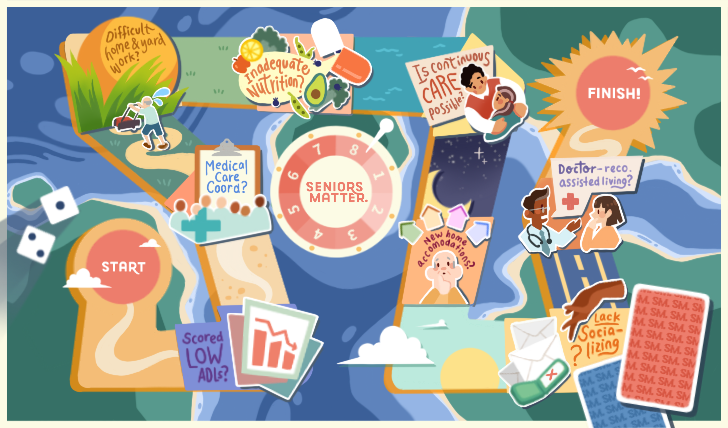
Options for seniors who need assistance
In some cases, adding physical therapy or purchasing assistive devices such as shower seats, grab bars, and taller toilets can help seniors continue to live independently. However, if your loved one scored low on the ADL or IADL charts, it may be best to look into assistive care.
Private duty home care
For seniors who are fairly independent and prefer to stay in their homes, Private Duty Home Care attendants offer minor assistance with ADLs as well as IADLs. According to Genworth, the average cost of monthly in-home care in 2020 was $4,500.
Private duty services:
- Bathing and hygiene
- Dressing
- Shopping
- Meal preparation
- Laundry
- Transportation
- Help with paying bills
- Scheduling appointments
- Companionship and emotional support
Assisted living
Seniors who need consistent help with daily tasks but don’t need constant medical care may thrive in an assisted living facility. Residents live in private apartments, but services to help them with ADLs and IADLs are regularly scheduled or at least always available. They also have access to medical help and are encouraged to socialize with other residents. Average cost according to Genworth for a one-bedroom assisted living apartment in 2020 was $4,300 per month.
Assisted living services:
- 24-hour supervision and security
- Three nutritious meals per day to meet dietary needs
- Medication management, if needed
- Basic housekeeping
- Laundry
- Transportation to doctor’s visits
- Access to medical services
- Exercise programs
- Social programs and entertainment
Skilled nursing
If your loved one has had surgery, a physical injury, a stroke or another type of medical setback and needs short-term constant supervision, skilled nursing is the best option. This type of facility typically provides rehabilitation services after hospitalization to get seniors back into their own homes. Medicare usually pays for short-term stays in skilled nursing facilities.
In a skilled nursing facility, your family member will have access to:
- Doctors
- Registered nurses
- Physical therapists
- Speech pathologists
- Audiologists
Memory care
Forgetting to pay bills, confusion over medications, putting things in odd places, and wandering are all signs that your loved one may be in the early stages of dementia. In a memory care facility, he or she will have structured, low-stress routines and a secure setting where they can’t get lost. Just like in an assisted living facility, meals are provided and help is available for essential daily tasks. But activities are geared to improve cognitive function, so they often include art and music therapy. AARP says memory care requires more specialized care, so it costs approximately $1,000 to $4,000 more per month than assisted living.
- Private, or semi-private rooms
- 24-hour personal assistance
- Three daily meals
- Housekeeping
- Laundry
- Medication management
- Exercise and physical therapy programs
- Social programs
Nursing home
Nursing homes are for seniors who need around-the-clock care on a long-term or permanent basis. Certified nurses provide assistance with bathing, dressing, and eating, but licensed medical practitioners are not always present.
The right care at the right time
The best option for your loved one will no doubt be a difficult decision, but one that’s necessary for the best health and happiness of everyone involved. If you need help finding facilities in your area that meet your loved one’s needs, see our Top 10 Guide.
